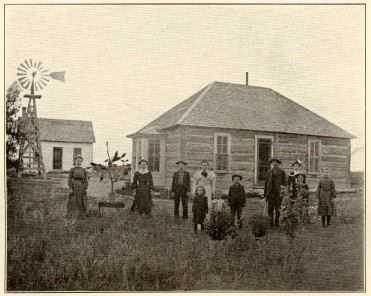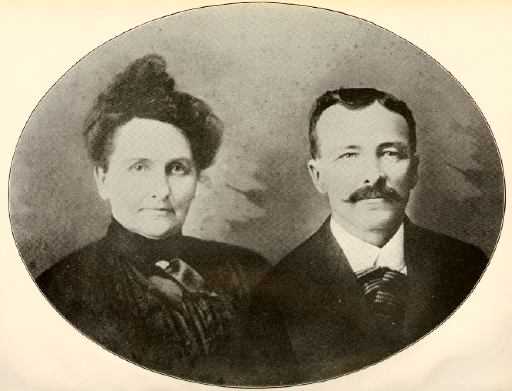 OLD FARM RESIDENCE OF MR. AND MRS. GREEN. Twenty-five miles south of Morrill, in Banner County, Nebraska.  MR. AND MRS. L. A. GREEN. |
edifice was built in their neighborhood and the old structure stood until some twelve years ago when it came down to be replaced by a more pretentious building. The mother of Mr. Spahr died in 1869 but the father survived until 1889. William C. Spahr attended the district schools and remained at home until eighteen years of age. By that time Indiana like Ohio had become so closely settled that the young and ambitious man began to look westward, as had his father, for opportunity to expand. It was this spirit that settled Nebraska. Mr. Spahr did not get father west than Illinois for the next six years, in the meanwhile working on farms in different sections of that state, then went to Nebraska and lived in Burt county until April, 1886, when he filed on a tree claim in Banner county, returning then to Fremont where he lived until the following spring, when with team and covered wagon he drove back to Banner county and here he has lived continuously ever since. In spring of 1887 he took a pre-emption and lived there three years, then bought a relinquishment and on this land still makes his home. Mr. Spahr did not find either comfortable or encouraging conditions when he first came to Banner county, but he was more resourceful and courageous than many of the early settlers and finally weathered the storm. Lack of money as a circulating medium was a great hardship in the earlier days and Mr. Spahr tells of working in the hayfield from sunup to sundown, for seventy cents a day. When he looks at his own and his neighbor's trucks and tractors and other modem means of transportation, he remembered the long time it took him to cover sixty-five miles to Kimball, with his heavy load of wood that had to be sold for what it would bring in order to be exchanged, for flour and needful groceries. He frequently drove to Cheyenne in order to get long delayed mail. There was no starvation in this section for deer and antelope were plentiful and every settler knew how to use a gun. During the first winter Mr. Spahr killed five deer and in the next spring when William Dunn, another early settler, visited with him while selecting a location, he gave Mr. Dunn the hides. The latter took them back with him to Iowa and had them tanned. At the present price of hides, there are many the country over, who today would welcome such a valuable gift. Mr. Spahr now owns and farms almost five sections of land, and raises eighty calves and two carloads of White Face cattle annually. With the help of his capable and industrious son and daughter, Mr. Spahr continues to operate the ranch himself. On August 14, 1892, Mr. Spahr was married to Miss Nellie Montgomery, who died in May, 1910, leaving two children: Onno L. and Vida. In politics Mr. Spahr is a staunch Republican. He served one term as assessor and as long as he would consent to fill the office, was school director in his district. Mr. Spahr can relate many interesting incidents of early life here and has had business or social acquaintance with the most of the other early settlers. MILTON M. GREEN, who was born in Pike county, Ohio, October 9, 1854, and died May 18, 1910, highly respected by all who knew him. He was a son of Isaac and Martha (Waltz) Green, both of whom died when he was young. He attended school in boyhood at Piketon, Ohio, and had a home with his two uncles until he was grown. Afterward, until his marriage, he was employed as a farmer in different sections, but finding little opportunity to establish himself in Ohio, where land was dear, decided to, go west and grow up with the country. On October 1, 1878, Mr. Green was united in marriage to Miss Louise A. Arledge, of Circleville, Ohio, where her mother yet resides. Her father died November 11, 1911. Mr. and Mrs. Green left Ohio and moved to Missouri, locating near Sedalia on a farm for which they paid a comparatively large cash rent. Conditions were such that they could raise practically no crops and then it was that they determined to make another change that brought them to Banner county. They then sold their best team of horses, as it was considered too good for traveling over such unbroken country as they knew their road lay. They had five children by that time and and thus, after reaching their new home they had an extension built on the covered wagon, and thus after reaching their new home they had some semblence (sic) of a dwelling and made use of it for some time. With the friendliness that very generally prevailed among the early settlers, a neighbor ploughed a small tract and Mrs. Green set about planting a garden. In recalling that time Mrs. Green says she was better able to see the bright side than was Mr. Green. He felt particularly discouraged on the day above mentioned as he had lost his best horse on the way, and seeing her actively preparing for the future by putting in garden seeds, asked her if she felt as if she really could stand living in so desolate a place as the homestead proved to be. With a cheer- |
fulness that might possibly have been assumed, she assured him she could and they "would make the best of it." He was permitted to live long enough to find "the best of it" very good indeed. Mr. Green then bought an ox team and cut and hauled wood from the canyons. The family reached Banner county May 1, 1889, and secured a pre-emption and tree claim in Banner county and homesteaded just across the line in Wyoming. Mrs. Green, with thrifty eastern ways, raised chickens and turkeys during the first years and the eighty dollars she received for her poultry was a very welcome addition to the family purse. About this time a Mr. David, who owned the C. P. Ranch near the Greens, came to see if his new neighbors would be willing to go there and superintend the ranch as his foreman had left. At that time the ranch had sixty-eight head of cattle. Mr. and Mrs. Green accepted the offer and they remained with Mr. David for thirteen years, operating the ranch so well and profitably that the owner was more than satisfied. Great care had to be exercised at all times on account of cattle thieves, and Mrs. Green suspects that they have not all been eliminated yet. Thirteen chidren (sic) were born to Mr. and Mrs. Green, and the following survive: Clara, who lives at Mitchell, Nebraska, is the wife of John Manaird; Myrtle, who is the wife of Frank Sushatt, of near Chugwater, Wyoming; Anna, who is the wife of Ayre Chamberlain, near Kimberly, Idaho; Maud, who is the wife of James Shoemaker, of Kimberly, Idaho; Ernest, who lives near the home place, married Ida Rung; Hazel, who is the wife of Ruel Schindler, of near Gary, Nebraska; Orrin and Afton, both of whom live with their mother; Selina, who lives at home is the widow of Clarnece (sic) Stemler; and Waldo and Nellie, both of whom are at home. This family has been carefully reared and well educated. At first, the older children went to school when they had no accommodations, not even seats, in the schoolrooms and a great scarcity of books. After Mr. Green's death, Mrs. Green filed a homestead claim and proved up on the same in 1917. She is now living on the Wyoming homestead and with the help of her sons farms and operates over two thousand acres, her shipment of cattle yearly averaging two cars. Mr. Green was a Democrat in politics. He never accepted any public office except school director and served as such for many years. There is no family in this section held in higher regard than the Greens. LEVI B. SPEAR, who came early to Banner county and lived here peacefully and usefully for a quarter of a century, was well and favorably known. He was an intelligent, industrious pioneer, a good neighbor and a man of sterling character. He was born in Somerset county, Pennsylvania, January 11, 1845, and died on his homestead in Banner county April 17, 1912. Very little is known of his parents aside from the fact that they were James and Catherine (Bowlin) Spear. The mother was born in Pennsylvania. The father was born in Ireland and died when his son was seven years old, the latter being brought up by an uncle. During his entire life he followed agricultural pursuits. On March 22, 1887, Mr. Spear was united in marriage to Sarah M. Spear, who was born in Chittendon county, Vermont, October 18, 1846. Her parents were Matthew and Gertrude (Forsythe) Spear. Immediately after their marriage, Mr. and Mrs. Spear started for Banner county, Nebraska, in a covered wagon drawn by a team of mules, and arrived on the homestead, which Mrs. Spear yet owns, on April 15, 1887. On the day following Mr. Spear began plowing, and that year, in spite of blizzard and hail storms, they grew some corn and as fine a lot of potatoes as anyone could wish to see. The notable May blizzard that brought suffering and distress to so many of the early settlers, found the Spears totally unprepared, with no well dug nor any barn or shelter put up. As the storm grew more and more furious, Mr. Spear adopted the only possible way to preserve his stock, bringing the cows to the house and sheltering them with the wagon boxes and actually taking his own mules and those of Edward Campbell, into the house and there the animals and people had to stay during the twenty hours the storm raged. It was not until August 8, 1889 that the Spears had an experience with a Nebraska hail storm, and their loss in growing crops was heavy, but they bore it courageously as they suffered no more than their neighbors. Mr. Spear continued to develop his homestead and then took a Kinkaid claim, on which Mrs. Spear and their son Ralph still live, the latter operating all the land. Ralph A. Spear, an only child, was born May 23, 1889, was educated in Banner county and has always lived at home. He now operates eight hundred and forty acres, raising from twenty to fifty head of cattle yearly, mostly Durhams, with a few good horses and some hogs. Mr. |
|
|
|
|
|